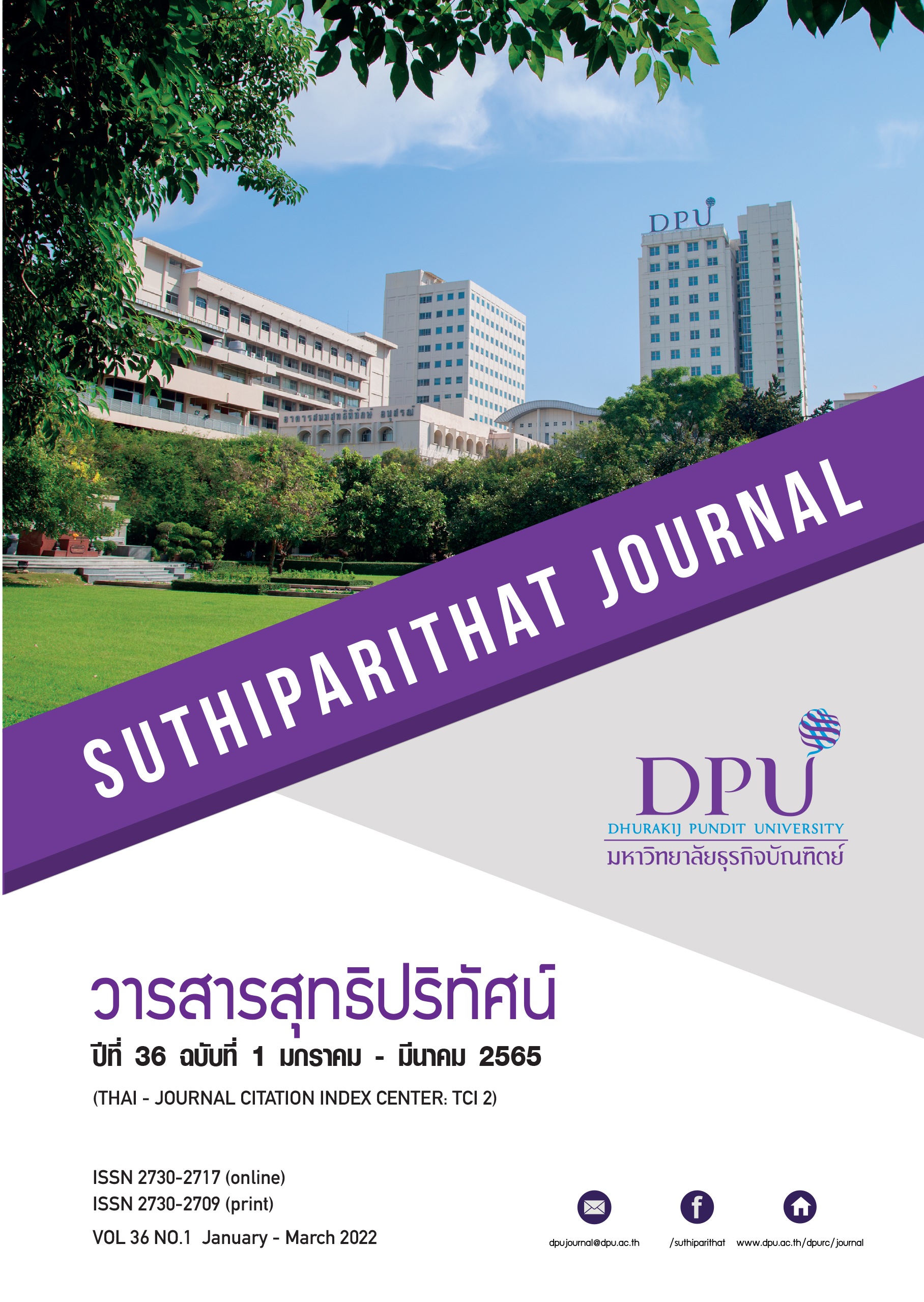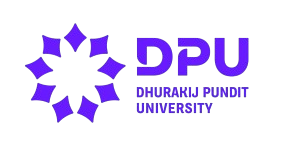ปัจจัยที่ส่งผลต่อความสำเร็จในการนำเทคโนโลยีสารสนเทศมาใช้ในวิชาชีพบัญชี
คำสำคัญ:
วิชาชีพทางด้านการทำบัญชี, เทคโนโลยีสารสนเทศ, เทคโนโลยีดิจิทัลบทคัดย่อ
องค์กรและวิชาชีพบัญชีจำเป็นจะต้องมีการเปลี่ยนแปลงการทำงานบนเทคโนโลยีสารสนเทศยุคปัจจุบัน ซึ่งจะช่วยเพิ่มมูลค่าในการดำเนินงาน ของวิชาชีพบัญชีเกิดผลสำเร็จตามนโยบายและแผนงานที่วางไว้ งานวิจัยครั้งนี้มีวัตถุประสงค์เพื่อวิเคราะห์องค์ประกอบเชิงยืนยันของปัจจัยที่ส่งผลต่อความสำเร็จในการนำเทคโนโลยีสารสนเทศมาใช้ในวิชาชีพบัญชี กลุ่มตัวอย่างในการศึกษาครั้งนี้ คือผู้ประกอบวิชาชีพทางด้านการทำบัญชีที่ขึ้นทะเบียนกับกรมพัฒนาธุรกิจการค้า และสภาวิชาชีพบัญชีในพระบรมราชูปถัมภ์ จำนวน 398 ราย โดยใช้แบบสอบถามเป็นเครื่องมือในการวิจัย ทำการวิเคราะห์ข้อมูลโดยการวิเคราะห์องค์ประกอบเชิงยืนยัน เพื่อตรวจสอบความตรงเชิงโครงสร้างของโมเดล
ผลการตรวจสอบความสอดคล้องของโมเดลปัจจัยที่ส่งผลต่อความสำเร็จในการนำเทคโนโลยีสารสนเทศมาใช้ในวิชาชีพบัญชีมีความสอดคล้องกับข้อมูลเชิงประจักษ์ โดยพิจารณาจากค่า x2 =27.878 df= 18 p= .064 CMIN/DF= 1.549 TLI= .993 CFI= .998 RMR= .008 และ RMSEA= .037 ค่าน้ำหนักองค์ประกอบมาตรฐานของตัวแปรทุกตัวมีค่าเป็นบวก มีค่าระหว่าง 0.461-1.000 ผลการวิจัยพบว่าปัจจัยที่ส่งผลต่อความสำเร็จในการนำเทคโนโลยีสารสนเทศมาใช้ในวิชาชีพบัญชีมี 4 ด้าน ได้แก่ ด้านเทคโนโลยีดิจิทัล ด้านบุคคลและองค์กรสมัยใหม่ ด้านสภาพแวดล้อม และด้านความสำเร็จของระบบสารสนเทศดิจิทัล โดยปัจจัยที่มีน้ำหนักองค์ประกอบมากที่สุดคือ ด้านเทคโนโลยีดิจิทัล และด้านบุคคลและองค์กรสมัยใหม่ และปัจจัยที่มีองค์ประกอบน้ำหนักน้อยที่สุดคือ ความสำเร็จของระบบสารสนเทศดิจิทัล ผลการศึกษาครั้งนี้เป็นประโยชน์ต่อผู้ประกอบวิชาชีพบัญชี และผู้บริหารองค์กร เพื่อใช้เป็นแนวทางในการปรับเปลี่ยนองค์กร อันจะส่งผลให้การดำเนินงานเกิดประสิทธิภาพ และประโยชน์ต่อผู้ใช้บริการต่อไป
เอกสารอ้างอิง
จิรภัทร มิขันหมาก, นิสารัตน์ โสดามุก, ปณิสรา ตันติกุลชาติ, และนลินภัสร์ บำเพ็ญเพียร. (2564). ปัจจัยที่ส่งผลต่อการยอมรับการใช้แอปพลิเคชั่นเป๋าตัง. ใน การประชุมวิชาการเสนอผลงานวิจัยระดับชาติ ด้านวิทยาศาสตร์และเทคโนโลยี ครั้งที่ 4 (น. 103-108). กรุงเทพฯ: มหาวิทยาลัยราชภัฏจันทรเกษม.
ฐปนพรรษ์ นุทกาญจนกุล. (2560). ผลกระทบและการเตรียมความพร้อมของนักบัญชีไทยต่อปัญญาประดิษฐ์ (AI) (วิทยานิพนธ์ปริญญามหาบัณฑิต). กรุงเทพฯ: มหาวิทยาลัยธรรมศาสตร์.
ฐาปนพงศ์ กลิ่นนิล, อัญญิฐาดิษฐานนท์, และอรพรรณ คงมาลัย. (2559). องค์ประกอบด้านความสำเร็จของระบบสารสนเทศในการซื้อสินค้าออนไลน์บริบทสินค้าเด็ก. วารสารบัณฑิตวิทยาลัย มหาวิทยาลัยสวนดุสิต, 12(3), 21-37.
ณัฐพัชร์ อภิรุ่งเรืองสกุล, และประสพชัย พสุนนท์. (2561). การวิเคราะห์ปัจจัยที่มีผลต่อการทำธุรกรรมทางการเงินผ่าน QR Code ในเขตกรุงเทพมหานคร. วารสารปัญญาภิวัฒน์, 10(109), 26-40.
ปฐมภูมิ วิชิตโชติ. (2558). การประยุกต์การใช้เทคโนโลยีสารสนเทศกรณีศึกษาการใช้งานโปรแกรม GLPI ของพนักงานบริษัทในเครือวาลีโอ (วิทยานิพนธ์ปริญญามหาบัณฑิต). ชลบุรี: มหาวิทยาลัยบูรพา.
พรชนิตว์ ลีนาราช. (2560). ทักษะการรู้ดิจิทัลเพื่อพัฒนาคุณภาพการเรียนรู้. วารสารห้องสมุด, 61(2), 76-92.
พลศรี ลีลาพัฒนวงศ์, และทิพวรรณ ปิ่นวนิชย์กุล. (2562). ปัจจัยที่มีอิทธิพลต่อการยอมรับนวัตกรรมและเทคโนโลยี: กรณีศึกษายานยนต์ไฟฟ้าประเภทยานยนต์นั่งส่วนบุคคลไม่เกิน 7 คน (รย.1). วารสารวิจัยและพัฒนา มจธ., 42(2), 129-144.
พิชิต ฤทธิ์จรูญ. (2554). ระเบียบวิธีการวิจัยทางสังคมศาสตร์ (พิมพ์ครั้งที่ 5). กรุงเทพฯ: เฮ้าส์ ออฟ เคอร์มีสท์.
พีรันธร ฉัตราภรณ์วิเชียร, และเพ็ญจิรา คันธวงศ์. (2561). ปัจจัยที่มีอิทธิพลเชิงบวกต่อการรับรู้ของผู้บริโภคในเขตธนบุรี กรุงเทพมหานครต่อระบบชำระเงินอิเล็กทรอนิกส์. ใน การประชุมวิชาการของมหาวิทยาลัยเกษตรศาสตร์ ครั้งที่ 56 (น. 640-649). กรุงเทพฯ: มหาวิทยาลัยเกษตรศาสตร์.
เพ็ญนภา เกื้อเกต, ภูริชาติ พรหมเต็ม, และวิโรจน์ ไพบูลย์เวชสวัสดิ์. (2560). ความสัมพันธ์ระหว่างความเป็นมืออาชีพของนักบัญชียุคดิจิทัลและประสิทธิภาพ การดำเนินงานของกิจการห้างหุ้นส่วนจำกัดในจังหวัดยะลา. วารสารการบัญชีและการจัดการ มหาวิทยาลัยมหาสารคาม, 12(1), 153-166.
วิชญ์ศุทธ์ เมาระพงษ์. (2561). เพิ่มมูลค่าข้อมูลธุรกิจด้วย Data mining. TPA news ดอทคอม, 169, 10-11. สืบค้นจาก http://www.tpa.or.th/tpanews/upload/mag_content/44/ContentFile712.pdf
ศิริเดช คำสุพรหม, เสาวรัตน์ บุญสง่า, ธาริน พองชัยภูมิ, และเปรมวดี กระตุฤกษ์. (2561). ปัจจัยความสำเร็จการใช้ระบบ SAP ของพนักงานบัญชีในบริษัทกลุ่มเทคโนโลยีสารสนเทศและการสื่อสารจดทะเบียนในตลาดหลักทรัพย์แห่งประเทศไทย. วารสารสุทธิปริทัศน์, 32(พิเศษ), 140-152.
ศุภศิมา ศรีบุญชัย. (2557). คุณลักษณะที่พึงประสงค์ในมุมมองของบริษัทเขตจังหวัดกรุงเทพมหานคร: กรณีศึกษาบริษัทที่เป็นคู่ค้ากับบริษัท สยาม โอคาย่า แมชชีน แอนด์ ทูล จำกัด. วารสารธุรกิจปริทัศน์, 6(2), 91-105.
ศูนย์วิจัยกสิกรไทย. (2560). เทคโนโลยีช่วย SME โตไม่หยุด ยุคดิจิทัล. สืบค้น 9 สิงหาคม 2560, จาก Technology-helps-SME-in-digital-age.pdf
สมคิด สุทธิธารธวัช, พรสิน สุภวาลย์, พรเลิศ อาภานุทัต, วรรณภา ฐิติธนานนท์, และขวัญมิ่ง คำประเสริฐ. (2561). ปัจจัยที่ส่งผลต่อการนำเทคโนโลยีสารสนเทศมาใช้ในเทศบาลตำบลของไทย. วารสารวิชาการการจัดการเทคโนโลยีสารสนเทศและนวัตกรรม, 5(2), 114-126.
สมาคมธนาคารไทย. (2560, 30 สิงหาคม). สมาคมธนาคารไทยประกาศมาตรฐานชำระเงินผ่าน QR CODE พร้อมเริ่มใช้งานจริงไตรมาสที่ 4. สืบค้น 25 พฤษภาคม 2564, จาก https://www.techtalkthai.com/standardized-qr-code-for-electronic-payment/
อังคณา พิมมา, อัมพล ชูสนุก, และวุฒินิพงษ์ วราไกรสวัสดิ์. (2559). ปัจจัยที่ส่งผลต่อการรับรู้ประโยชน์ การใช้งาน และความพึงพอใจของผู้ใช้งานระบบการจัดการความรู้ในโรงพยาบาลรัฐบาล. Veridian E-Journal Silpakorn University, 9(2), 1432-1451.
อัญณิฐา ดิษฐานนท์, และภริตา พงษ์พาณิชย์. (2560). ปัจจัยหลักที่ใช้ในการตัดสินใจนำระบบคลาวด์คอมพิวติ้งมาใช้ในอุตสาหกรรมธุรกิจประกันชีวิตของประเทศไทย. วารสารการจัดการสมัยใหม่, 15(1), 99-112.
อุเทน เลานำทา. (2562). ความสามารถด้านดิจิทัลเทคโนโลยีของนักบัญชี.วารสารเอกสารภาษีอากร, 38(454), 12-13. สืบค้นจาก https://www.dst.co.th/index.php?option=com_content&view=article&id=3613:ability-digital-technology-accountant&catid=29&Itemid=180&lang=en
Amal, F. S. (2020). Diabetes diseases prediction using supervised machine learning and neighbourhood components analysis. In NISS2020: Proceedings of the 3rd International Conference on Networking, Information Systems & Security (pp. 1-5). Association for Computing Machinery.
Amirul, S. M., Mail, R. M., Abu Bakar, A., & Ripain, N. (2018). Information technology knowledge and skills for accounting graduates: An insight from public accounting firms. Indian Journal of Science and Technology, 10(12), 1-6. Retrieved from https://doi.org/10.17485/ijst/2017/v10i12/112976
Che Azmi, A., Sharoja, N., Mustapha, M., & Abdullah, M. (2016). SMEs’ tax compliance costs and IT adoption: The case of a value-added tax. International Journal of Accounting Information Systems, 23, 1-13. Retrieved from https://doi.org/10.1016/j.accinf.2016.06.001
Byrne, B. M. (2001). Structural equation modeling with AMOS : Basic concepts, applications, and programming Multivariate applications book series. Lawrence Erlbaum Associates Mahwah.
Carmines, E. G., & McIver, J. P. (1981). Analyzing models with unobserved variables: Analysis of covariance structures'. In GW Bohrnstedt & EF Borgatta (Eds), Socia measurement: Current issues. Canada: Sage Beverly Hills.
Carlson, M., & Mulaik, S. A. (1993). Trait ratings from descriptions of behavior as mediated by components of meaning. Multivariate Behavioral Research, 28(1), 111-159. Retrieved from https://doi.org/10.1207/s15327906mbr2801_7
Clark, H. H. (1973). The language-as-fixed-effect fallacy: A critique of language statistics in psychological research. Journal of verbal learning and verbal behavior, 12, 335-359.
Delone, W., & McLean, E. (1992). Information systems success: The quest for the dependent variable. Journal of Management Information Systems, 3(4), 60-95. Retrieved from http://doi.org/10.1287/isre.3.1.60
DeLone, W., & McLean, E. (2003). The DeLone and McLean model of information systems success: A ten-year update. Journal of Management Information Systems, 19(4), 9-30. Retrieved from https://doi.org/10.1080/07421222.2003.11045748
DeLone, W., & McLean, E. (2008). Measuring information systems success: Models, dimensions, measures, and interrelationships. European Journal of Information Systems, 17, 236-263.
Hu, L., & Bentler, P. M. (1998). Fit indices in covariance structure modeling: Sensitivity to under parameterized model misspecification. Psychological Methods, 3(4), 424-453. Retrieved from https://psycnet.apa.org/doi/10.1037/1082-989X.3.4.424
Jiao, F. (2015). Towards operational cost minimization in hybrid clouds for dynamic resource provisioning with delay-aware optimization. IEEE Transactions on Services Computing, 8(3), 398-409.
Kim, K., Kim, S. H., Kim, J., Kim, H., & Yim, J. (2012). Glutathione s-transferase omega 1 activity is sufficient to suppress neurodegeneration in a Drosophila model of Parkinson's disease. J. Biol. Chem, 287(9), 6628-6641. Retrieved from https://doi.org/10.1074/jbc.m111.291179
Mansfield, E., Rapoport, J., Romeo, A., Wagner, S., & Beardsley, G. (1977). Social and private rates of return from industrial innovations. The Quarterly Journal of Economics, 91(2), 221-240. Retrieved from https://doi.org/10.2307/1885415
Mauricio., M., & James., H. (2019). The disruptive and transformative potential of new technologies for accounting, accountants, and accountability. Meditari Accountancy Research, 27(5), 677-694. Retrieved from https://doi.org/10.1108/MEDAR-06-2019-0508
Oliveira. (2016). Management accounting. New York: McGraw Hill.
Oliveira, T., & Martins, M. F. (2011). Literature review of information technology adoption models at firm level. The Electronic Journal of Information Systems Evaluation, 14(1), 110-121. Retrieved from https://academic-publishing.org/index.php/ejise/article/view/389/352
Petter, S., & Mclean, E. (2009). A meta-analytic assessment of the Delone and McLean IS success model: An examination of IS success at the individual level. International & Management, 46(3), 159-166. Retrieved from https://doi.org/10.1016/j.im.2008.12.006
Prisco, D. (2017). Blockchain and AI: The technological revolution’s impact on corporate governance relationships. In New Challenges in corporate governance: Theory and practice (pp.368-381). Naples.
PWC. (2017). PwC’s global blockchain survey. Retrieved November 2, 2019, from https://www.pwc.com/gx/en/industries/technology/blockchain/blockchain-in-business.html
Stair, R. M., Reynolds, G. W., & Chesney. (2010) Principle of information systems: A managerial approach. New York: The Free Press.
Tam, C., & Oliveira, T. (2016). Performance impact of mobile banking: using the task-technology fit (TTF) approach. International Journal of Bank Marketing, 34(4), 434-457. Retrieved from https://doi.org/10.1108/IJBM-11-2014-0169
Tornatzky, L.G., & Fleischer, M. (1990). The process of technology innovation. Lexington: Lexington Books.
Ullman, J. B. (2001). Structural equation modelling. In B.G. Tabachnick, & L.S. Fidell (Eds), Using multivariate statistics (4th ed.). United State: Allyn & Bacon.
Wu, Y. L., Tao, Y. H., & Yang, P. C. (2007). Using UTAUT to explore the behavior of 3G mobile communication users. In Industrial Engineering and Engineering Management, 2007 IEEE International Conference (pp. 199-203). Singapore. Retrieved from https://doi.org/10.1109/IEEM.2007.4419179
Yu, C. (2002). Evaluating cutoff criteria of model fit indices for latent variable models with binary and continuous outcomes (Doctoral dissertation). California: University of California.
ดาวน์โหลด
เผยแพร่แล้ว
รูปแบบการอ้างอิง
ฉบับ
ประเภทบทความ
สัญญาอนุญาต
ลิขสิทธิ์ (c) 2022 มหาวิทยาลัยธุรกิจบัณฑิตย์

อนุญาตภายใต้เงื่อนไข Creative Commons Attribution-NonCommercial-NoDerivatives 4.0 International License.
เนื้อหาและข้อมูลในบทความที่ลงตีพิมพ์ในวารสารสุทธิปริทัศน์ ถือเป็นข้อคิดเห็นและความรับผิดชอบของผู้เขียนบทความโดยตรงซึ่งกองบรรณาธิการวารสาร ไม่จำเป็นต้องเห็นด้วย หรือร่วมรับผิดชอบใด ๆ
บทความ ข้อมูล เนื้อหา รูปภาพ ฯลฯ ที่ได้รับการตีพิมพ์ในวารสารสุทธิปริทัศน์ ถือเป็นลิขสิทธิ์ของวารสารสุทธิปริทัศน์หากบุคคลหรือหน่วยงานใดต้องการนำทั้งหมดหรือส่วนหนึ่งส่วนใดไปเผยแพร่ต่อหรือเพื่อกระทำการใด ๆ จะต้องได้รับอนุญาตเป็นลายลักษณ์อักษรจากวารสารสุทธิปริทัศน์ก่อนเท่านั้น







